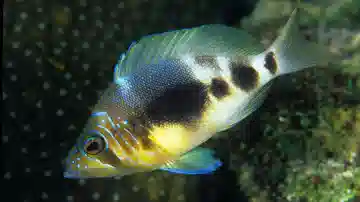Indigo Hamlet - Atlantic
Hypoplectrus indigo
(2 Reviews)

Indigo Hamlet - Atlantic
Hypoplectrus indigo
(2 Reviews)
{{ item.name }}
Size: {{ item.extra_field_3 }}
${{ getFormattedPrice(item.saleprice) }} ${{ getFormattedPrice(item.price) }}
To join the waiting list, click here
Free Shipping
With
$199.00
or more in Marine Life.
More details...
Indigo Hamlet - Atlantic Care Facts
| Care Level: | Moderate |
|---|---|
| Temperament: | Semi-Aggressive |
| Diet: | Carnivore |
| Reef Safe: | No |
| Minimum Tank Size: | 70 gallons |
| Max Size: | 6 inches |
The Indigo Hamlet is hermaphrodite in nature and has both male and female sexual organs, so breeding has been done in captivity. With its beautiful coloration, temperament and general availability, the Indigo Hamlet makes a beautiful addition to any tank. The Indigo Hamlet should be kept in a tank with plenty of open spaces for swimming. The Indigo Hamlet requires plenty of caves and crevices so that it can hide when threatened. The Indigo Hamlet is a carnivorous fish and should be fed with meaty foods 2 to 3 times per day for its continued good health.
Indigo Hamlet (Hypoplectrus indigo) - A Comprehensive Guide for Saltwater Aquarium Enthusiasts
The Indigo Hamlet (Hypoplectrus indigo) is a fascinating species that captivates saltwater marine aquarium enthusiasts with its vibrant colors and engaging behavior. This product description provides valuable insights into the care and maintenance of these captivating fish, offering essential information for hobbyists looking to add them to their saltwater aquariums.
Habitat and Reef Compatibility of the Indigo Hamlet:
Indigo Hamlets are native to the Western Atlantic, primarily found in the Caribbean. They inhabit coral reefs and rocky areas in their natural habitat, seeking shelter among crevices and caves. While they are considered reef-safe, caution is advised when keeping them in a coral-rich environment, as they may occasionally nip at small invertebrates. Properly introducing and acclimating them to a reef tank can minimize potential issues.
Size and Lifespan of the Indigo Hamlet:
Indigo Hamlets are relatively small, reaching an average size of 6 inches in captivity. They can live for up to 10 years with proper care, making them a long-term commitment for dedicated hobbyists.
Diet of the Indigo Hamlet in Captivity:
Maintaining a well-balanced diet is crucial for the health of Indigo Hamlets in captivity. They are carnivorous by nature, and their diet should include high-quality marine pellets, frozen or live brine shrimp, mysis shrimp, and small crustaceans. Regular feeding sessions throughout the day will ensure their nutritional needs are met.
Aquacultured Availability of the Indigo Hamlet:
Indigo Hamlets are not widely aquacultured, making them predominantly collected from the wild. However, conscientious suppliers like Saltwaterfish.com are committed to sourcing their marine life responsibly, contributing to the conservation of coral reefs and marine ecosystems.
Compatibility of the Indigo Hamlet with Other Fish and Invertebrates:
Indigo Hamlets exhibit a peaceful temperament, making them suitable for community aquariums. They can coexist with various compatible tank mates, provided the tank is appropriately sized and structured. Care should be taken to avoid aggressive or territorial species that may threaten the well-being of the Indigo Hamlet.
Sexual Dimorphism of the Indigo Hamlet:
Distinguishing between male and female Indigo Hamlets can be challenging, as they do not display significant sexual dimorphism. Observing their behavior during spawning is often the most reliable method for determining gender.
Juvenile to Adult Coloration Changes in the Indigo Hamlet:
As juveniles, Indigo Hamlets display a striking blue coloration that intensifies as they mature. Adults boast an exquisite indigo hue derived from their common name. The vibrant colors make them a captivating addition to any marine aquarium.
Temperament of the Indigo Hamlet:
Known for their peaceful nature, Indigo Hamlets are an excellent choice for community tanks. They generally coexist harmoniously with other non-aggressive species, creating a serene and visually appealing aquarium environment.
Tank Requirements of the Indigo Hamlet:
- A minimum aquarium size of 70 gallons is recommended to ensure the well-being of Indigo Hamlets.
- The tank should provide ample hiding spaces and a variety of structures to mimic their natural habitat.
- Additionally, proper water conditions are crucial.
Water Conditions for the Indigo Hamlet:
- Maintaining optimal water parameters is essential for the health of Indigo Hamlets:
- pH: 8.1 to 8.4
- Salinity: 1.020 to 1.025
- Water Temperature: 75°F to 80°F
- Water Flow: Moderate to high flow is preferable, mimicking the ocean currents of their natural habitat.
Other Common Names for the Indigo Hamlet:
The Indigo Hamlet may also be called Indigo Hamlet Basslet or simply Indigo Basslet in the aquarium trade.
Five Compatible Tank Mates for the Indigo Hamlet:
- Foxface Rabbitfish (Siganus vulpinus)
- Flame Angelfish (Centropyge loriculus)
- Royal Gramma (Gramma loreto)
- Clownfish (Amphiprion spp.)
- Coral Beauty Angelfish (Centropyge bispinosa)
Why Buy from Saltwaterfish.com:
Saltwaterfish.com stands out as a reputable source for marine life, emphasizing sustainable and ethical practices in collecting and distributing marine species. With a commitment to customer satisfaction and the well-being of marine ecosystems, Saltwaterfish.com ensures that its Indigo Hamlets are healthy, responsibly sourced, and acclimated to captivity.
In conclusion, the Indigo Hamlet is a captivating addition to any saltwater aquarium, offering a blend of beauty and tranquility. With proper care and attention to their specific requirements, these stunning fish can thrive in a well-maintained marine environment, creating a visually stunning and harmonious aquatic display for enthusiasts. Consider acquiring your Indigo Hamlet from Saltwaterfish.com, where responsible sourcing meets hobbyists' and marine ecosystems' needs.
I bought one here last November and he survived a trip to MN in cold weather with a warmer pack. His bag water when opened was at 68 degree but after slow acclimation he did fine and has been swimming around my 40 gal Reef Tank since. He is now about 3 1/2 inches and a peaceful tank mate in my tank of 7 peaceful fish, i.e. 2 clowns, 3 pajama cardinals and a pygmy angel. Sometimes he will briefly chase the angel but does no harm. I have soft corals in my tank as well as hermit crabs, an arrow crab and 2 other crabs. He does not bother any of these. He adds color to the tank and sometimes it looks like he is looking at me with his big eyes.
Reviewed by: Phil on Jan. 7, 2015
Reviewed by: Rocky on Nov. 6, 2014












